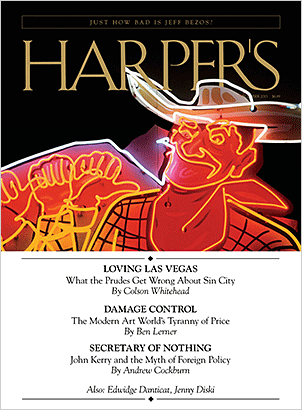Introducing the December 2013 Issue
Colson Whitehead on Las Vegas, Ben Lerner on vandalism as art, and Edwidge Danticat on photographs from Africa
 Because half of my extended family lives on the East Coast and half on the West Coast, we have tried to organize large gatherings in Las Vegas, considered by some of the West Coasters to be reasonably priced and accessible to everyone. I have always resisted, having thought of the city as tacky. But Colson Whitehead’s essay in this month’s Harper’s Magazine changed my mind. “I pity people who’ve never been to Las Vegas,” Whitehead begins. “Who dismiss the city without setting foot on its carpeted sidewalks.” He goes on to describe Vegas, contrary to those who think of it only as a refuge for down-and-out gamblers, as a city that brings joy to millions.
Because half of my extended family lives on the East Coast and half on the West Coast, we have tried to organize large gatherings in Las Vegas, considered by some of the West Coasters to be reasonably priced and accessible to everyone. I have always resisted, having thought of the city as tacky. But Colson Whitehead’s essay in this month’s Harper’s Magazine changed my mind. “I pity people who’ve never been to Las Vegas,” Whitehead begins. “Who dismiss the city without setting foot on its carpeted sidewalks.” He goes on to describe Vegas, contrary to those who think of it only as a refuge for down-and-out gamblers, as a city that brings joy to millions.
In Andrew Cockburn’s second report as the magazine’s Washington Editor, he looks at the role of secretary of state, a position widely believed to be powerful. But the real might in shaping foreign policy, Cockburn demonstrates, lies very much behind the scenes, with such communities as the Cuban expatriates of Miami, and with people most of us have never heard of—men like Bernard H. Barnett, a rare Jewish Republican, who in the mid-twentieth century lobbied successfully on behalf of Israel, but who goes unmentioned in the standard histories of that era.
Ben Lerner, who last wrote for Harper’s on high school debating (“Contest of Words,” October 2012), examines several notorious instances of art vandalism—the defacing of Rothko’s Black on Maroon with a black paint pen; the spray-painting of a matador and bull on Picasso’s Woman in a Red Armchair—and notes that the destruction of established works of art has a “long and sanctioned history in the avant-garde.” Lerner reasons that this practice, which vandals claim adds rather than detracts from the worth of the original pieces, calls into question the value assigned to works of art—a value, he argues, that is more or less arbitrary.
In a rare and intimate look at the lives of undocumented immigrants in his home state of North Carolina, contributing editor Duncan Murrell spent several months with a family he calls the Almanzas. Esteban and Maria Almanza have six children, and they’ve been in the United States for ten years, working in a chicken-processing plant. A few months after Murrell meets them, Maria is arrested for working under a false name, leaving the whole family in danger of being deported. Murrell’s beautifully written essay depicts an unfortunately too-typical modern American immigrant story, showing us a family that, no matter their official status, is very much American.
In his Easy Chair column this month, Thomas Frank returns to Chicago, where he lived for a number of years, and laments the changes that have taken place: a city once populated by poor graduate students and hippies has become a mecca for upwardly mobile professionals and foodies, despite its now record-breaking murder rate.
Also in this issue: a new story by Ben Marcus; Christopher Beha on the work and legacy of Norman Mailer; Jenny Diski on the allure of the glamorous; James Marcus on whether Amazon can change its predatory ways; and a portfolio of images from Africa with accompanying text by Edwidge Danticat.



